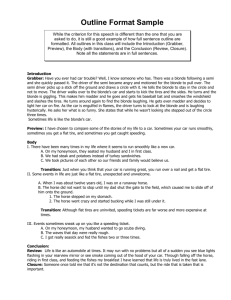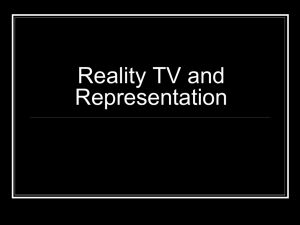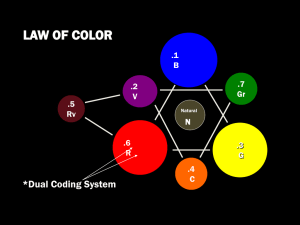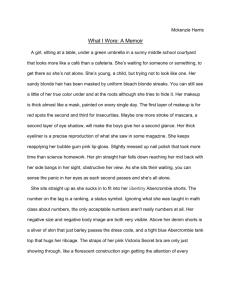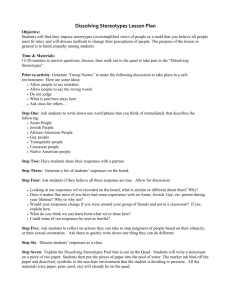File
advertisement
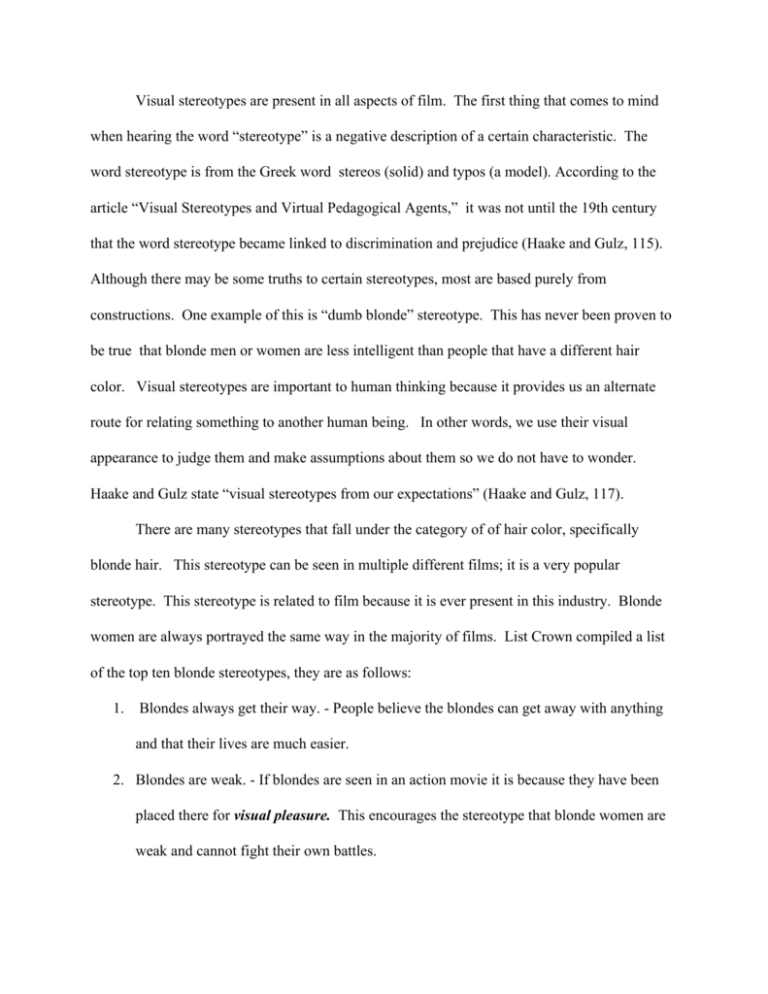
Visual stereotypes are present in all aspects of film. The first thing that comes to mind when hearing the word “stereotype” is a negative description of a certain characteristic. The word stereotype is from the Greek word stereos (solid) and typos (a model). According to the article “Visual Stereotypes and Virtual Pedagogical Agents,” it was not until the 19th century that the word stereotype became linked to discrimination and prejudice (Haake and Gulz, 115). Although there may be some truths to certain stereotypes, most are based purely from constructions. One example of this is “dumb blonde” stereotype. This has never been proven to be true that blonde men or women are less intelligent than people that have a different hair color. Visual stereotypes are important to human thinking because it provides us an alternate route for relating something to another human being. In other words, we use their visual appearance to judge them and make assumptions about them so we do not have to wonder. Haake and Gulz state “visual stereotypes from our expectations” (Haake and Gulz, 117). There are many stereotypes that fall under the category of of hair color, specifically blonde hair. This stereotype can be seen in multiple different films; it is a very popular stereotype. This stereotype is related to film because it is ever present in this industry. Blonde women are always portrayed the same way in the majority of films. List Crown compiled a list of the top ten blonde stereotypes, they are as follows: 1. Blondes always get their way. ­ People believe the blondes can get away with anything and that their lives are much easier. 2. Blondes are weak. ­ If blondes are seen in an action movie it is because they have been placed there for visual pleasure. This encourages the stereotype that blonde women are weak and cannot fight their own battles. 3. Blondes are only interested in their looks. ­ Blondes are portrayed as people who are shallow and materialistic. They are seen as people who spend their time grooming and putting on makeup. 4. Blondes are popular.­ Blonde girls are portrayed as the popular girls in highschool or the head cheerleader. They are seen walking down hallways with their group following. 5. Blondes are mean.­ As a result of this stereotype, people believe that blondes are self centered and have no regard for others feeling. this can be seen in the movie Mean Girls. 6. Blondes have a low IQ.­ Most people consider blondes to have a low IQ. This stereotype can be seen in many films. 7. Blondes aren’t street smart. ­ Blondes are depicted as dressed to the nines, walking around in heels and driving in a nice part of town. They are rarely seen “toughing it out.” 8. Blonde bombshell­ Women with blonde hair are considered to be sexy and synonymous with beauty. The media reinforces the stereotype that if you are blonde, you are beautiful. 9. Dumb Blonde­ This is the most common stereotype and is commonly see through dumb blonde jokes. Blondes are considered to be dumb and not smart enough to understand what is going on around them. 10. Blondes are only female.­ Blondes are only seen as being female, people tend to forget that men can have blonde hair. These stereotypes are only formed around blonde women.. (List Crown, 2014). Almost all of these stereotypes can be seen in everyday films. Some examples of these films include Mean Girls, House Bunny, Gossip Girl, and White Chicks. These are among the hundreds of films that embody this stereotype. According to (stereotypeoftheday.com) “The stereotypical dumb blonde has been used extensively in television and movies. Next to her hair color, the stereotype has two main aspects: the girl is pretty and she lacks intelligence.” This stereotype of blondes being in film as visual pleasure is resounding of Laura Mulvey’s article, “Visual Pleasure and Narrative Cinema.” In her article Mulvey states that women are placed in films in a role that is powerless. They do not make any executive or important decisions, these women are here for the purpose of gazing. In her article she talks about “the gaze.” In a film there is a male gaze, a point of view through which the film is seen. This male gaze places women in a role where they are meant to be seen as visual pleasure (Mulvey). Mulvey states “in a world ordered by sexual imbalance, pleasure in looking has been split between active/male and passive/female. The determining male gaze projects its phantasy on to the female figure which is styled accordingly” (Mulvey, 808). This gaze can be seen in these stereotypes as well. For example, blonde women are placed in films and seen as weak people who need to be protected (by a strong, leading male character) because they cannot defend themselves. This is 100% a result of the male gaze; we now see women as weak and fragile creatures who need the help of a male. They do not accomplish anything important accept being beautiful and complying to whatever the male wants. We also are seeing what is “beautiful” through the male gaze. The stereotype of the blonde bombshell is a result of the male gaze, its a result of what they find to be beautiful. For example, in the film Vertigo, the female character Madeline was a blonde beautiful woman who was in the film to be stared at. The settings and atmosphere changed when she entered the room, we were able to see her through the male gaze yet again. Another example of these stereotypes being a result of the male gaze is the last stereotype on the List Crown list “ Blondes are only female.” No male would want to be seen as unintelligent; they do not fall under any of the other stereotypes. It is very rare that you will find a movie with a male character that exhibits the same characteristics as a blonde female character ( unless its in Barbie Life in the Dreamhouse). Blonde women are made to feel inferior as a result of the male gaze. This is also due to the fact that most movies are directed/ produced by males, giving them the power to place women in these inferior roles however they please. There are many movies that exemplify these blonde stereotypes. one example of this is Mean Girls. In this film, the head “mean girl” Regina George is blonde. She is the most popular girl in the school and she is very mean. She is also beautiful and materialistic. the other blonde character, Karen is portrayed as the dumb blonde who is highly unintellegent. She says things that do not make sense, she takes things out of context, and appears to be lost at all times. These women embody the blonde stereotype in many ways throughout this film. Another film that casted the blonde woman as a stereotypical role is House Bunny. The main character is a playboy bunny. She is seen as the beautiful, sexy blonde but she is also very stupid. She shows a young group of college girls how to fit in and be accepted by the other fraternities and sororities at their college, giving them tips that only a playboy bunny would give. The movie White Chicks also shows the blonde stereotypes in a nontraditional way. Two undercover agents are pretending to be two famous blonde girls. Throughout the movie they are seen trying to act like the characters they are trying to impersonate. When the real girls come onto the screen they are just as dumb, if not more than their impersonators. In this film, blonde women are shown to be very unintellegent and superficial. As a result of resources such as Laura Mulvey, we are able to see the correlation between visual pleasure, the male gaze, and stereotypes. These blonde stereotypes are a direct result of the male gaze and how society has construed images of women and their intelligence based on their hair color. The full spectrum of blonde stereotypes can be seen throughout history in many films; from Vertigo and Some Like it Hot to House Bunny and Mean Girls, this stereotype is always present. Even though these are constructed stereotypes that hold no truth, they are very popular and can corrupt the minds of young women, teaching them that this is the correct way to behave if you want attention from males. All of this warped sense of beauty, popularity, and intelligence is a result of the male gaze and influence that it has on films. Works Cited Haake, Mangus, and Agneta Gulz. Visual Stereotypes and Pedagogical Agents. Vol. 11. N.p.: Educational Technology & Society, n.d. 115­17. Print. Mulvey, Laura. Visual Pleasure and Narrative Cinema. N.p.: n.p., n.d. 802­09. Print. Top 10 Blonde Stereotypes. N.p., n.d. Web. 11 Dec. 2014. The Dumb Blonde . N.p., 8 May 2013. Web. 11 Dec. 2014. <http://stereotypeoftheday.blogspot.com/2013/05/the­dumb­blonde.html>.

